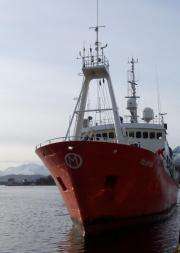Measuring carbon dioxide over the ocean

Reliable measurements of the air-sea flux of carbon dioxide - an important greenhouse gas - are needed for a better understanding of the impact of ocean-atmosphere interactions on climate. A new method developed by researchers at the National Oceanography Centre, Southampton (NOCS) working in collaboration with colleagues at the Bjerknes Center for Climate Research (Bergen, Norway) promises to make this task considerably easier.
Infrared gas sensors measure carbon dioxide based on its characteristic absorption spectra and are used to evaluate the air-sea flux of the gas. So-called closed-path sensors precondition air before measurements are made, while open-path sensors can be used to measure the air in situ.
One advantage of using open-path sensors at sea is that wind measurements can be taken contemporaneously in the same place. Moreover, because they are small and don't use much power they can be used on buoys.
"Open-path sensors have the potential greatly to increase our understanding of the variability of air-sea carbon dioxide fluxes," said PhD student John Prytherch of the University of Southampton's School of Ocean and Earth Science at NOCS.
However, a long-standing concern has been that the values from open-path sensors do not tally with those from closed-path sensors, or with measurements made using other techniques.
"Other scientists have been sceptical about the reliability of carbon dioxide flux measurements taken at sea using open-path sensors," says Prytherch: "However, we now believe that we understand the reason for the discrepancy and that we can correct for it."
The problem turns out to be that the sensors are sensitive to humidity, meaning that fluctuations in the amount of water vapour in the sample air skew the carbon dioxide measurements. This is probably caused by salt particles on the sensor lens that absorb water.
Having identified the problem, Prytherch and his colleagues developed and rigorously tested a novel method for correcting the data for the cross-sensitivity to humidity.
Data were collected aboard the Norwegian weather ship Polarfront, equipped with a battery of instruments to measure wind speed, humidity and carbon dioxide. Even the motion of the ship was monitored.
The researchers noted that the carbon dioxide fluxes calculated from open-path sensor data were clearly too high and affected by humidity. They were also very variable, suggesting that the effect is caused by salt on the optics, which accumulate before being washed off by rain. Indeed, the researchers were able to mimic this effect in the laboratory.
However, after correction using their newly developed method, the calculated carbon dioxide fluxes were in line with previous studies that used different sensors or techniques.
"This robust method opens the way for widespread use of open-path sensors for air-sea carbon dioxide flux estimation," said Dr Margaret Yelland of NOCS: "This will greatly increase the information available on the transfer of carbon dioxide between the air and sea - information crucial for understanding how the ocean-atmosphere interaction impacts climate."
More information: Prytherch, J., et al. Direct Measurements of the CO2 flux over the ocean: development of a novel method. Geophys. Res. Lett. (published on-line, 2010) doi:10.1029/2009GL041482
Provided by National Oceanography Centre, Southampton

















